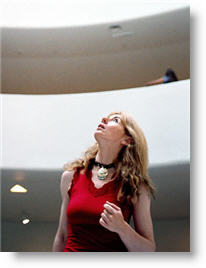Touch the Sound
| Moral Rating: | Good |
| Moviemaking Quality: |
|
| Primary Audience: | |
| Genre: | Documentary |
| Length: | 1 hr. 39 min. |
| Year of Release: | 2005 |
| USA Release: |
February 12, 2005 (film festival) |





| Featuring |
|---|
| Evelyn Glennie, Fred Frith |
| Director |
|
Thomas Riedelsheimer |
| Producer |
| Leslie Hills, Stefan Tolz, Trevor Davies |
| Distributor |
| Shadow Distribution |
Summary: Evelyn Glennie is a percussionist who is profoundly deaf, yet has won a Grammy award for her work. Thomas Riedelsheimer directs this documentary that captures her performing and philosophizing. The film has no MPA rating; it received a “PG” in Australia according to IMDB.com.
There are three strands vying for time and space in “Touch the Sound”. In one strand, world-class percussionist Evelyn Glennie performs. In another, she talks philosophically about art and music. In the third, director Thomas Riedelsheimer accompanies her music with visual images from nature and captures ambient sound from everyday settings to illustrate her music and speeches. I found one strand exhilarating, one odd but interesting, and one rather mundane.
As a performer, Glennie is someone I could listen to all day. As a philosopher, not so much. The opposite of sound isn’t silence, we are told, it is… something else. Static maybe. Sound goes away but is never really lost. When we lose one of our senses, the other senses compensate for that loss.
When Glennie talks about her own experiences, she is a bit more eloquent, less abstract. She relates a telling story of how the medical profession declared that she could not be a musician once she was diagnosed, and how she thought it was odd that all the things she could already do thirty minutes prior were declared too difficult for someone in her condition. It was also rewarding to see her turn the question of “how do you hear music?” back on the metaphorical questioners. Most people, she suggests, don’t understand how they hear through the ear; why is she called on to explain her process of listening to those who do not even understand their own?
The visuals that Riedelsheimer provides to accompany the music are often visually poetic. My only reservation is that I felt at times like I was watching a live action version of “Fantasia”. I would have preferred seeing the performers play the music to some of Riedelsheimer’s montages, especially in a film that emphasizes the physical aspects of creating and receiving sound. Then again, the visuals do tend to remind us of the thin and at times arbitrary line between manufactured music and ambient sounds. All three threads encourage viewers to listen attentively, whether it be to a performance piece or the sounds of their environment. If we do so, the film seems to suggest, we will notice more of the latent beauty in our world, stuff that we might otherwise tune out.
I probably would have enjoyed “Touch the Sound” more if it had simply been a concert film or a series of vignettes of the musicians collaborating and performing. Of course, such a film would have been much harder to market and sell. The cynic in me also kept wondering whether Riedelsheimer’s visuals were a collaboration with Glenn’s music or were simply a co-oping of it. Those concerns aside, viewers who enjoy percussion music are in for a treat.
My Grade: B
Violence: None / Profanity: None / Sex/Nudity: None


PLEASE share your observations and insights to be posted here.